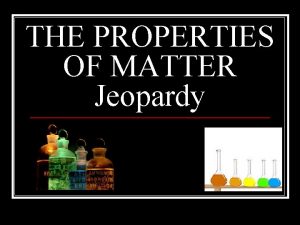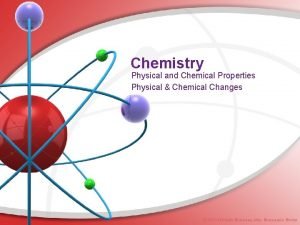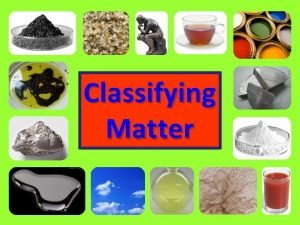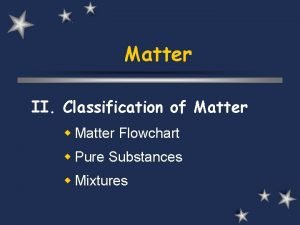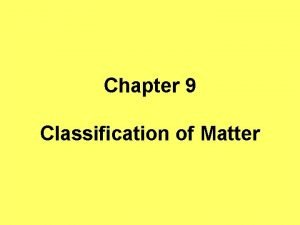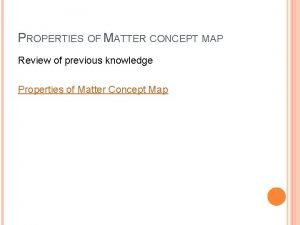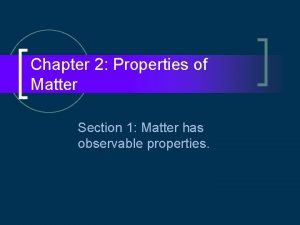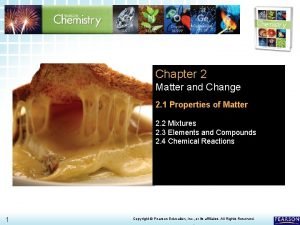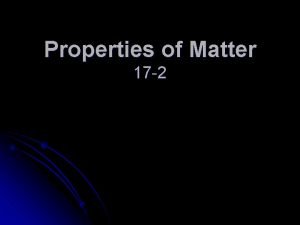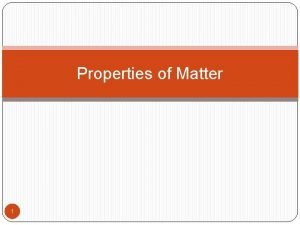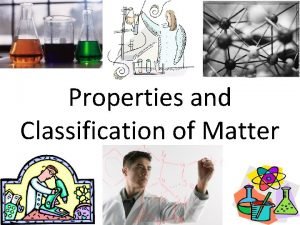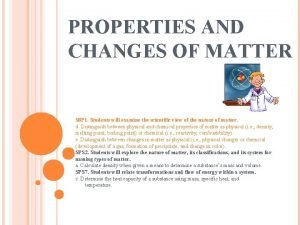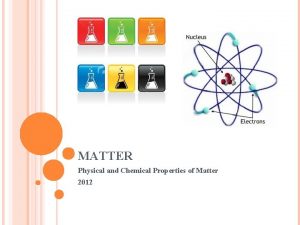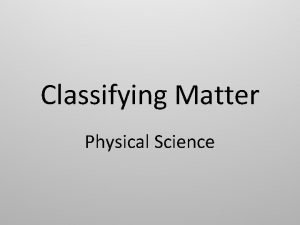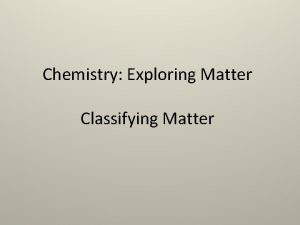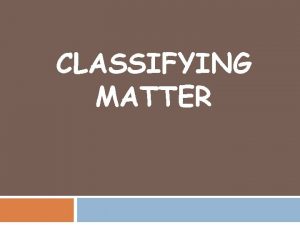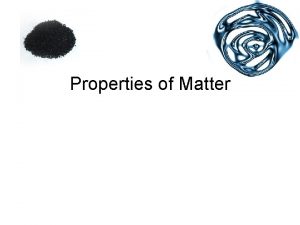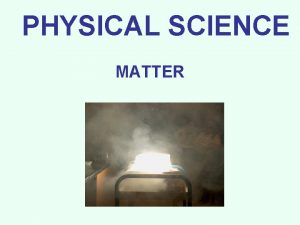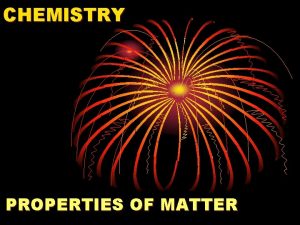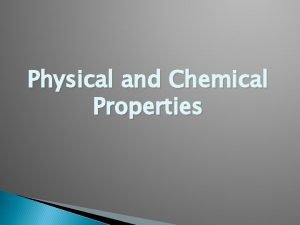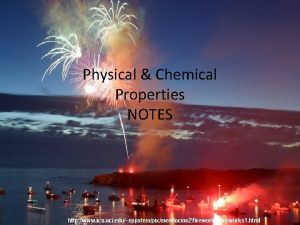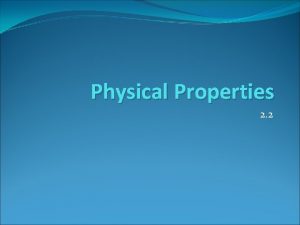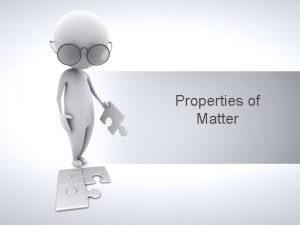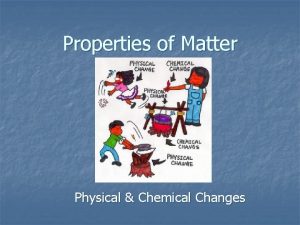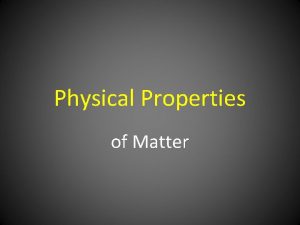Chapter 2 Properties of Matter Classifying Matter Physical






















- Slides: 22

Chapter 2 Properties of Matter Classifying Matter Physical Properties Chemical Properties

What is Matter? • Anything that takes up space and has mass.

There are different kinds of Matter • Pure Substances – Elements – Compounds • Mixtures – Solutions – Colloids – Suspensions

• A classification scheme for matter. Solution Suspension Colloid

Pure Substances • A substance is either an element or a compound. • Always has exactly the same composition. • Every sample has the same properties because it has a fixed, uniform composition.

Elements • If all the atoms in a substance are alike—then you are observing an element. • 90 elements are naturally occurring, most are unstable.

Elements • Each has a one or two letter symbol • First letter is always capitalized, second letter is lower case • Some have Latin names

Compounds • Materials that are made up of 2 or more elements combined in a definite or fixed proportion. (i. e. , salt, sugar, water) • The ratio of different atoms, is always the same. Water (H 2 O) = 2 -H + 1 -0. • Compounds, generally, take on characteristics of their own and do not resemble the individual elements that compose them. • Can elements and compounds be separated by physical means? NO

Mixtures • A mixture is two or more substances mixed together, that can be separated by physical means (i. e. , salt, water). • Composition varies. • Two main types of mixtures: – Heterogeneous – Homogeneous

Homogeneous Mixtures • Two or more substances blended evenly throughout. • Also called solutions, which remain constantly and uniformly mixed. • Examples: – Soda – Vinegar

Heterogeneous Mixtures • Do not always contain the same proportions of each ingredient. • Not every part of the mixture has the same composition. • Examples: – Granite – Dry soup mix – Trail mix

Suspension • Heterogeneous mixtures. • Generally, there is a liquid with some sort of “stuff” that can settle out.

Colloids • Colloids never settle. • They are Heterogeneous Mixtures. • These particles are big enough to scatter light. • Examples: – Milk – Fog – paint

Fog • A colloid composed of water droplets suspended in the air. • Particles in the air can scatter the light, making fog. (hard to see through) • The scattering is known as the “Tyndall Effect”.

Physical Properties • A physical property of a material is a characteristic that can be observed without changing the substances that make up or compose the material.

Physical Changes • Change in: – Shape – State of matter (i. e. , breaking chalk, freezing) • When a physical change occurs, the actual substance does not change.

Some Physical Properties • Describes: – – – – – Appearance (Color, Shape) Measurements (Size) Density Melting point (State of Matter) Boiling point (State of Matter) Viscosity Conductivity Malleability Hardness

Using Physical Properties • Physical properties can be used to separate mixtures. - Filtration - Distillation


Chemical Change • The changing of one substance to another substance. • Change in: – – Smell Foaming Light, sound, or heat Examples—rusting & burning - Flammability Reactivity Change in color (Sometimes) Formation of a precipitate

Chemical Properties • Are only seen when the substance is changing into a different substance.

Conservation of Mass • Matter cannot be created or destroyed. • A burning log. Where does the mass go?
 Chapter 2 section 1 classifying matter answer key
Chapter 2 section 1 classifying matter answer key Physical properties and chemical properties
Physical properties and chemical properties Physical properties of matter jeopardy
Physical properties of matter jeopardy Graphic organizer for classification
Graphic organizer for classification Physical properties of notebook paper
Physical properties of notebook paper Classifying matter quiz
Classifying matter quiz Classifying matter flowchart
Classifying matter flowchart Worksheet classification of matter
Worksheet classification of matter Matter is classified as
Matter is classified as What is classification of matter
What is classification of matter Classification of matter flow chart
Classification of matter flow chart Classification of matter quiz
Classification of matter quiz Concept map properties of matter
Concept map properties of matter Chapter 2 properties of matter
Chapter 2 properties of matter Chapter 2 properties of matter answer key
Chapter 2 properties of matter answer key Extensive vs intensive
Extensive vs intensive Properties of liquid state of matter
Properties of liquid state of matter Properties of matter vocabulary
Properties of matter vocabulary Objectives of properties of matter
Objectives of properties of matter General property of matter
General property of matter Classification and properties of matter
Classification and properties of matter Properties and changes of matter worksheet
Properties and changes of matter worksheet Measurable properties of matter
Measurable properties of matter


